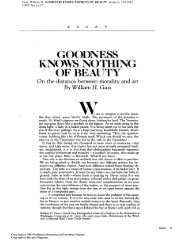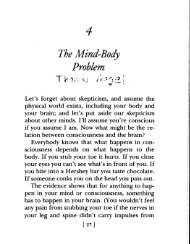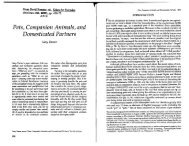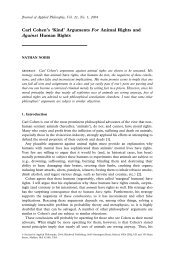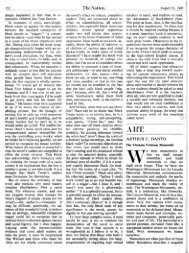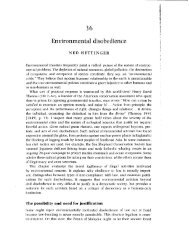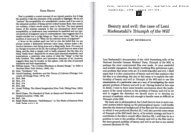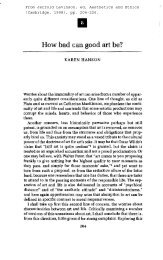Bruce Baugh, "Prolegomena to Any Aesthetics of Rock Music"
Bruce Baugh, "Prolegomena to Any Aesthetics of Rock Music"
Bruce Baugh, "Prolegomena to Any Aesthetics of Rock Music"
You also want an ePaper? Increase the reach of your titles
YUMPU automatically turns print PDFs into web optimized ePapers that Google loves.
<strong>Baugh</strong> <strong>Prolegomena</strong> <strong>to</strong> <strong>Any</strong> <strong>Aesthetics</strong> <strong>of</strong> <strong>Rock</strong> Music27masses <strong>of</strong> sound with insistent and compellingrhythms.But beat is not the only thing, or the mostimportant. There is a significant body <strong>of</strong> highlyregarded rock music which has no swing, andwhich you can't dance <strong>to</strong> because you are notmeant <strong>to</strong> dance <strong>to</strong> it. From the mid-1960s onward,rock music broke out <strong>of</strong> the rigid confines<strong>of</strong> verse/chorus/verse in 4/4 time. But the significance<strong>of</strong> this change is not that it made rockmore interesting formally. The importance <strong>of</strong> thechange lay rather in the way it called in<strong>to</strong> questionsome <strong>of</strong> the boundaries rock set for itself,and opened up new possibilities for expressionthrough the matter <strong>of</strong> music, through elementsother than rhythm. Let me briefly summarizethe his<strong>to</strong>ry <strong>of</strong> how this transition <strong>to</strong>ok place.In rock music, the voice had always been themain vehicle <strong>of</strong> expression, and the fac<strong>to</strong>r thatcould make or break a song. One need onlycompare a Fats Domino original with its pallidPat Boone "cover" <strong>to</strong> see that the expressivity <strong>of</strong>the voice itself, rather than the composition,makes a rock song good. As in blues, it is theperformance that counts, and standards <strong>of</strong> evaluationare based on standards <strong>of</strong> performance.In this sense, rock music reverses the priorities<strong>of</strong> European concert hall music, and questions<strong>of</strong> "faithfulness" <strong>to</strong> the music rarely arise. Theonly question is whether the performance/interpretationis convincing, not whether it is "faithful"<strong>to</strong> some (usually non-existent) score. No onegot <strong>to</strong>o upset when Joe Cocker performed theBeatles' "With a Little Help From My Friends"in a way that was not in the least suggested by theoriginal recording. In fact, the originality <strong>of</strong>Cocker's interpretation was counted a virtue bymost. Listeners <strong>to</strong> European concert hall musicare not nearly so <strong>to</strong>lerant in this regard: they willaccept some deviation from the original score,but within limits established by the score itself,rather than by the effectiveness <strong>of</strong> the performance.Few discerning rock listener's liked Deoda<strong>to</strong>'spop version <strong>of</strong> Richard Strauss' Also SprachZarathustra, but they disliked it because it wasinane, not because it was a misinterpretation anda "sacrilege." Again, it is a matter <strong>of</strong> degree,but there is a heavier emphasis on performance,rather than composition, in rock music.These performance elements <strong>of</strong> rock musicare not easily accounted for by traditional aesthetics.The performance standards for rock vo-calists have little <strong>to</strong> do with the virtuosity <strong>of</strong> anopera singer or with an ability <strong>to</strong> hit the noteindicated in the composition at the time indicated.Some <strong>of</strong> the best rock vocalists, fromMuddy Waters <strong>to</strong> Elvis <strong>to</strong> Lennon <strong>to</strong> Joplin, aretechnically quite bad singers. The standards have<strong>to</strong> do with the amount <strong>of</strong> feeling conveyed, andwith the nuances <strong>of</strong> feeling expressed. On theother hand, it is not the vocalist who can sing thelongest and loudest who is best, either, heavymetalnotwithstanding. A good rock vocalist caninsinuate meaning with a growl or a whisper.This does constitute a virtuosity <strong>of</strong> sort, but onethat connects directly with the body, provoking avisceral response which may be complicated andhard <strong>to</strong> describe, but easy <strong>to</strong> recognize for thosewho have experienced it. Still, what the bodyrecognizes may not lend itself <strong>to</strong> notation orformalization, and it is unlikely that a moreadequate form <strong>of</strong> notation could capture these"material" qualities.In the 1960s, the modes <strong>of</strong> expression that hadbeen uniquely associated with the voice weretaken up, with various degrees <strong>of</strong> success, by theinstruments themselves, especially by the guitar.I will mention only two fairly striking examples,Cream's performance <strong>of</strong> the blues song "Spoonful"at the Fillmore Audi<strong>to</strong>rium in 1968,10 andJimi Hendrix's "Machine Gun," recorded inconcert on New Year's Day, 1970.11 Neither <strong>of</strong>these songs, as performed, have much in the way<strong>of</strong> musical structure, and they do not swing.'2But they do allow Clap<strong>to</strong>n, with Cream, andHendrix <strong>to</strong> explore different ways an electricguitar can sound. Both guitarists have been guilty<strong>of</strong> virtuosity for its own sake on many occasions,but in these performances, their playinggoes beyond mere show-boating. Clap<strong>to</strong>n's playingranges from droning sitar-like passages <strong>to</strong>bursts <strong>of</strong> tightly clustered notes; Hendrix's use<strong>of</strong> feedback in the central passage is the anguishthe music conveys, rather than the bald symbolism<strong>of</strong> his Woods<strong>to</strong>ck performance <strong>of</strong> "TheStar Spangled Banner."13 In both cases, the guitaristshave dropped their "see what I can dowith a guitar" pose in favor <strong>of</strong> "hear what I cansay with a guitar." And in both cases, it is amatter <strong>of</strong> how the <strong>to</strong>nes are played, not the <strong>to</strong>nesthemselves, that makes the music successful.In instances like these, rock achieves the expressivitythrough musical instruments moreclosely associated with jazz or blues, a use <strong>of</strong> the



